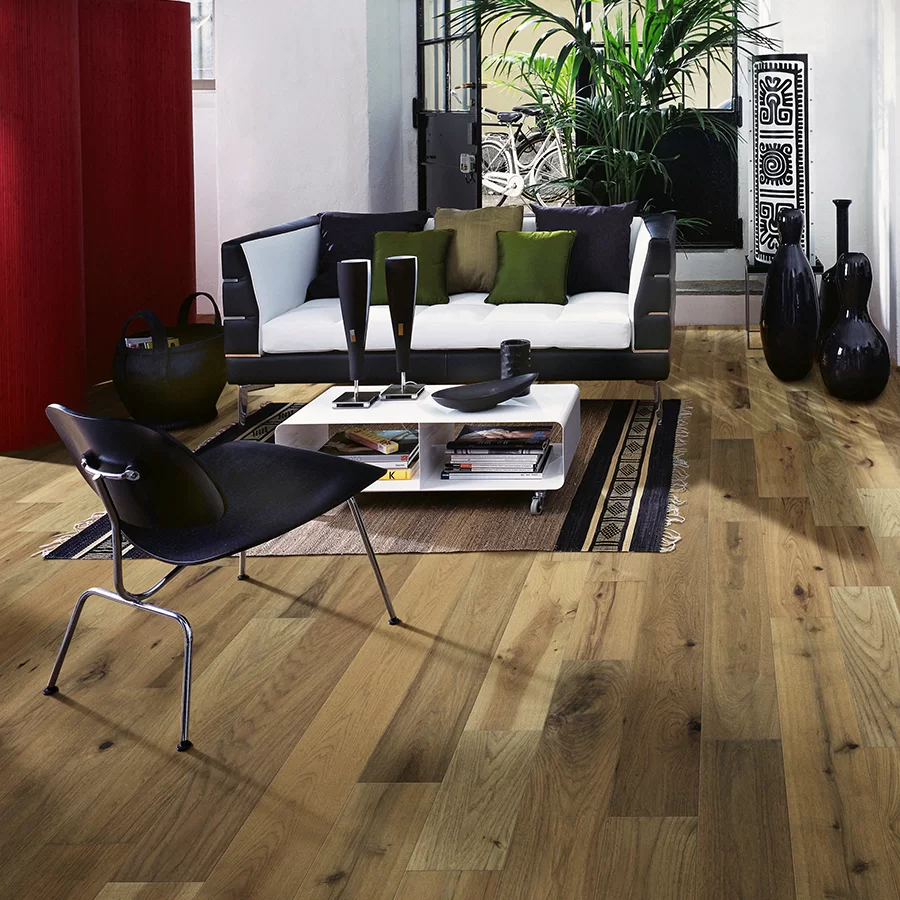When it comes to creating an accessible and accommodating living space for individuals using wheelchairs, the choice of flooring plays a pivotal role. Among the various options available, wood flooring emerges as a top contender, offering a blend of functionality, aesthetics, and ease of maintenance. In this article, we explore why wood flooring stands out as an excellent choice for wheelchair users.
Smooth Surface:
Wood flooring provides a consistently smooth and level surface, which is crucial for wheelchair mobility. Unlike carpets or uneven tile surfaces, wood floors eliminate the risk of tripping or getting stuck, offering a seamless experience for wheelchair users to navigate freely throughout a space. When a wood flooring is installed using glue down or nail down method transition moldings such as end caps and t-moldings can be omitted. These transitions are often a hinderance for wheels due to the increased elevation. The smooth texture of wood flooring facilitates easy movement of wheelchairs, requiring less effort for users to propel themselves. This is particularly beneficial for individuals with limited upper body strength, ensuring a more comfortable and efficient experience within the home.
Durability and Longevity:
Wood flooring is renowned for its durability and longevity. When properly maintained, it can withstand the wear and tear associated with wheelchair use, making it a cost-effective option in the long run. Additionally, many wood varieties are resistant to scratches and dents, preserving the aesthetic appeal of the flooring over time. A hardwood floor can be refinished many times in the future which prolongs their lifetime value.
Easy Maintenance:
Maintaining wood flooring is relatively straightforward, especially compared to other flooring options. Regular sweeping and occasional mopping are usually sufficient to keep wood floors clean. This simplicity in maintenance is advantageous for wheelchair users, as it minimizes the effort and time required to keep the living space in top condition. Wood flooring has natural insulating properties, helping to regulate room temperature. This can be particularly beneficial for wheelchair users who may spend extended periods of time in one area. Wood flooring provides a comfortable surface that does not become overly cold in winter or excessively warm in summer.
Aesthetic Versatility:
Wood flooring stands out as an ideal choice for wheelchair users, offering a harmonious blend of functionality and aesthetic versatility. Its smooth and level surface ensures effortless mobility, while the durability of various wood species caters to the wear and tear associated with wheelchair use. Beyond its practical advantages, wood flooring becomes a canvas for homeowners to express their unique style. The extensive range of colors, finishes, and patterns allows for personalized design choices, accommodating diverse interior preferences. Whether integrating into a modern or traditional setting, wood flooring seamlessly adapts, creating timeless and visually appealing spaces for wheelchair users.
The aesthetic versatility of wood flooring extends beyond the surface, with its compatibility with various design styles, texture and grain variations, and the ability to play with contrasts or coordination. Homeowners can leverage the timeless elegance of wood, ensuring that their spaces remain both accessible and aesthetically captivating over the years. In essence, wood flooring exemplifies the idea that accessibility need not compromise style, offering a functional and visually pleasing foundation for homes that truly cater to the needs and preferences of wheelchair users.
Adaptability for Ramps and Lifts:
Wood flooring’s adaptability for ramps and lifts is a crucial feature that enhances accessibility for individuals using wheelchairs. Unlike some flooring options that might pose challenges during modifications, wood effortlessly accommodates these adjustments without compromising the overall aesthetic coherence of the space. Its structural versatility allows for the seamless integration of ramps, ensuring a smooth transition between different levels in a home. This adaptability not only enhances mobility for wheelchair users but also maintains the visual integrity of the living environment.
The incorporation of ramps and lifts into wood flooring aligns with the principles of universal design, emphasizing the importance of inclusivity in home environments. Homeowners can enhance accessibility without sacrificing the cohesive and inviting ambiance of their spaces. In essence, wood flooring’s adaptability for ramps and lifts goes beyond functional convenience; it contributes to creating homes that are not only barrier-free but also visually appealing and accommodating for individuals with mobility challenges.
Conclusion:
In the pursuit of creating an inclusive and accessible living environment, the choice of flooring is a critical consideration. Wood flooring emerges as a standout option, providing a smooth, durable, and aesthetically pleasing surface that caters to the specific needs of wheelchair users. By combining functionality with style, wood flooring exemplifies the commitment to making homes welcoming and user-friendly for everyone.

